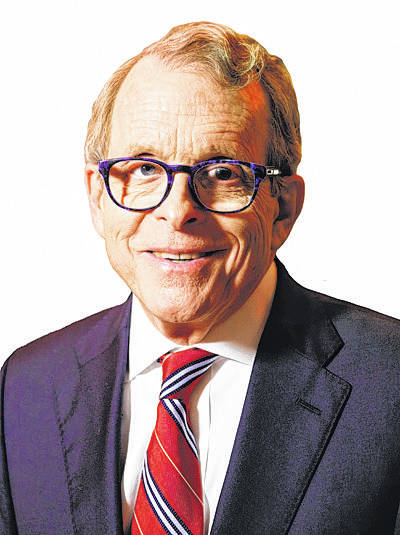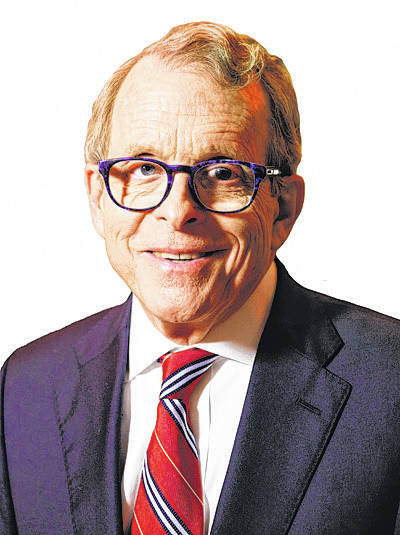

CEDARVILLE — As he walked into the kitchen of his cozy Cedarville home, Gov. Mike DeWine didn’t seem like a man working 24-7 trying to lead his state through a pandemic of proportions rarely seen.
National newscasts weren’t tuned in on TV.
No bags under his eyes.
No cowboy-sized coffee cups.
But you could hear it in his voice — the concern and the fear.
“It’s interesting times,” the Greene County native said Saturday shortly after returning home from his daily coronavirus media briefing in Columbus. “(But) I sleep.”
While trying to flatten the coronavirus curve, DeWine has set the bar for how other states will likely handle the public health emergency as it bombards the nation. That’s because DeWine tapped into his 40 years of government experience — and trusted his instinct — to make some aggressive decisions in order to protect Ohioans.
“The mistakes that I have made throughout my career have been primarily because I didn’t dig deep enough and get all the facts, didn’t ask enough questions,” DeWine said. “My experience has been when you have all the facts, and the facts are right, you generally make the right decisions. I’ve been really focused on getting the facts. This is not any area of my expertise at all.”
He then mentioned his wife, Fran, who he has known since the first grade and who knows DeWine’s academic history quite well.
“She got A’s in science and biology,” DeWine said. “Let’s just say I didn’t get A’s. It wasn’t even close to A’s. We’ve surrounded ourselves with people and utilized them to keep asking questions … and try to dig down and get the facts.”
DeWine said he also learned to trust his gut feeling. When he didn’t trust his intuition and allowed himself to be talked out of a decision, he “usually made a mistake.”
Tapping into history
DeWine said that he has been reading “The Great Influenza: The Epic Story of the Deadliest Plague in History” by John M. Barry and used it as an outline for how to approach the COVID-19 problem.
St. Louis jumped out ahead of the pandemic and cancelled its Liberty Loan parade while Philadelphia held the parade, reacted two weeks later and had more than 12,000 deaths while St. Louis had no more than 700.
“We had no idea this was coming,” DeWine said. “All the evidence is and all the people who model pandemics say that you have a small window, and to take these drastic actions, and if you don’t take them in that window of opportunity, it’s too late.”
DeWine said one wouldn’t think two weeks would make a difference but it did.
“We took these actions to save lives,” he said. “We know they are inconveniencing and they cause hardship to people. Discomfort. I took these actions because I knew from all the data they will in fact save lives.”
Data shows, DeWine said, that if no action had been taken, between 40 and 70 percent of all Ohioans would contract the virus.
“We think the action we’ve taken will knock that down some,” he said. “If it spikes up like it did in Italy … we don’t want to be in a situation like Italy is, where we have to decide who lives and who dies. That’s why we took the action.”
DeWine has been criticized by some on social media for doing too much too soon. But he would rather be overcautious than not cautious enough.
“If you’re going to make a mistake, it better be on the side of being too aggressive than not aggressive enough,” he said. “I’m the one that’s got to sleep with myself and live with myself.”
There’s always something
When he was elected, DeWine was forewarned by others who served to expect the unexpected.
“I had several former governors tell me there will be something that comes up that you had no idea was coming,” DeWine said.
George Voinovich, under whom DeWine served as lieutenant governor, had to deal with prison riots in Lucasville in 1993.
In his first year as governor, DeWine had to deal with the Memorial Day tornadoes in the Miami Valley and the Oregon District shooting. A water shortage and a KKK rally in Dayton also drew state-wide attention.
“You sort of expect a flood, you sort of expect tornadoes, this is Ohio,” DeWine said. “Coronavirus is, except for people who study these … it’s not something you think about. (But) everything I’ve done has prepared me for making these decisions. That doesn’t mean I’m making the right decision. If you get the facts, your odds go up pretty good.”
Leading by example
When the coronavirus first reared its ugly head, DeWine moved quickly to clear his schedule so he could focus on the battle about to ensue. He and Fran also cut back on their public schedule.
The First Lady was busy traveling around the state promoting the Imagination Library, which is up and running in just about every Ohio county. The governor also put off various appearances.
“You can’t be out there shaking hands with people,” DeWine said. “We’ve got to set the right example. They have to understand the importance of keeping separation from other people. We can impose so many rules but people have to use their own common sense. People by the day are getting more, there’s more understanding of the nature of this.”
DeWine said it’s what is expected of a state leader.
“Ultimately this is the type of crisis where a governor is supposed to step up,” he said. “You want the governor to take care of the most serious problems. This is what we do. What we’re supposed to do.”
And he has no doubt Ohio will survive.
“The sun is going to come up,” he said. “But it’s going to get darker before it gets lighter. Ohioans are resilient. I’ve seen them through tornadoes, I’ve seen them through the Oregon District shooting. Our goal is to get everybody through that two-month period or whatever it is. Ohioans will rally. We’ll make it.”


